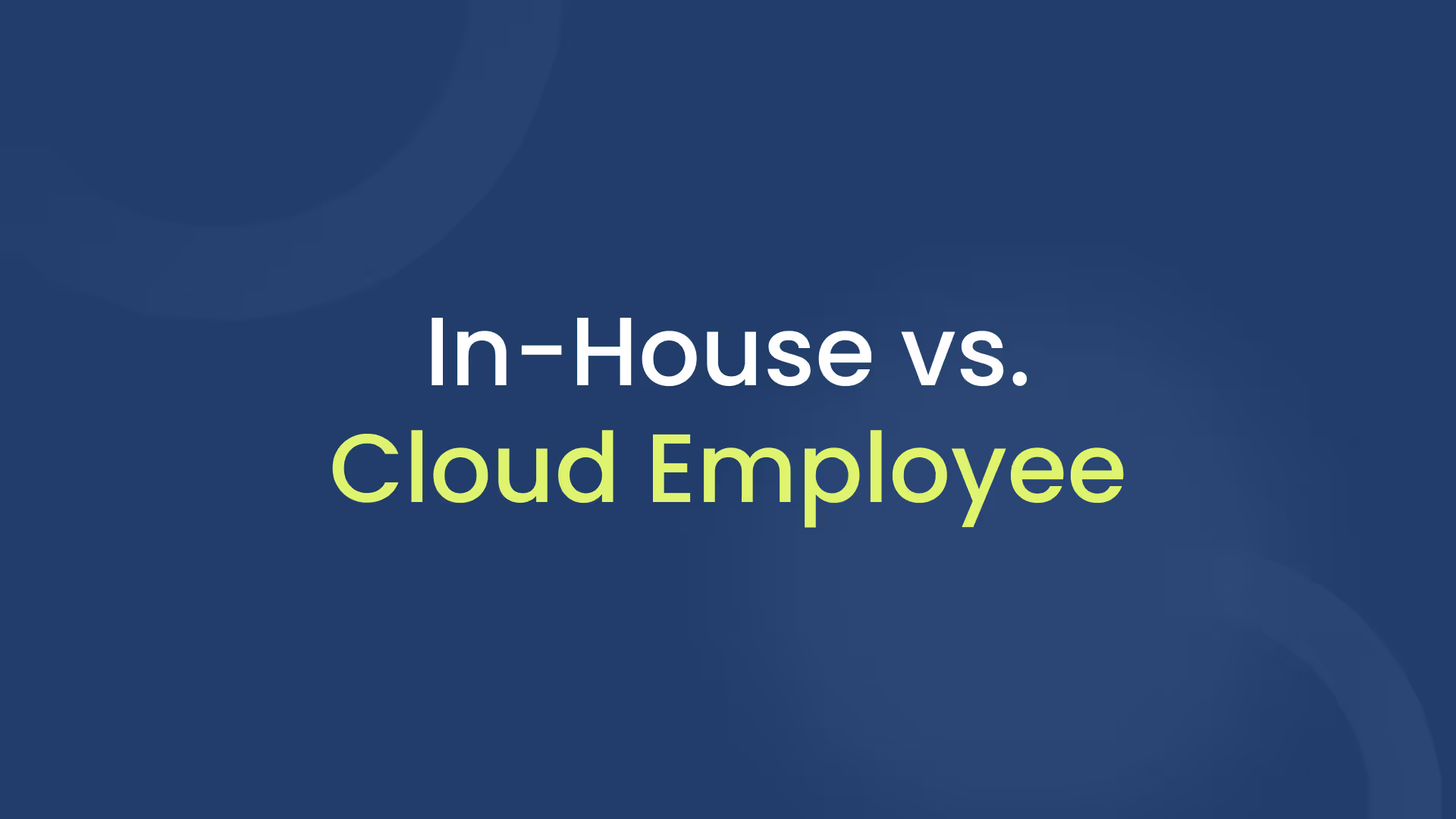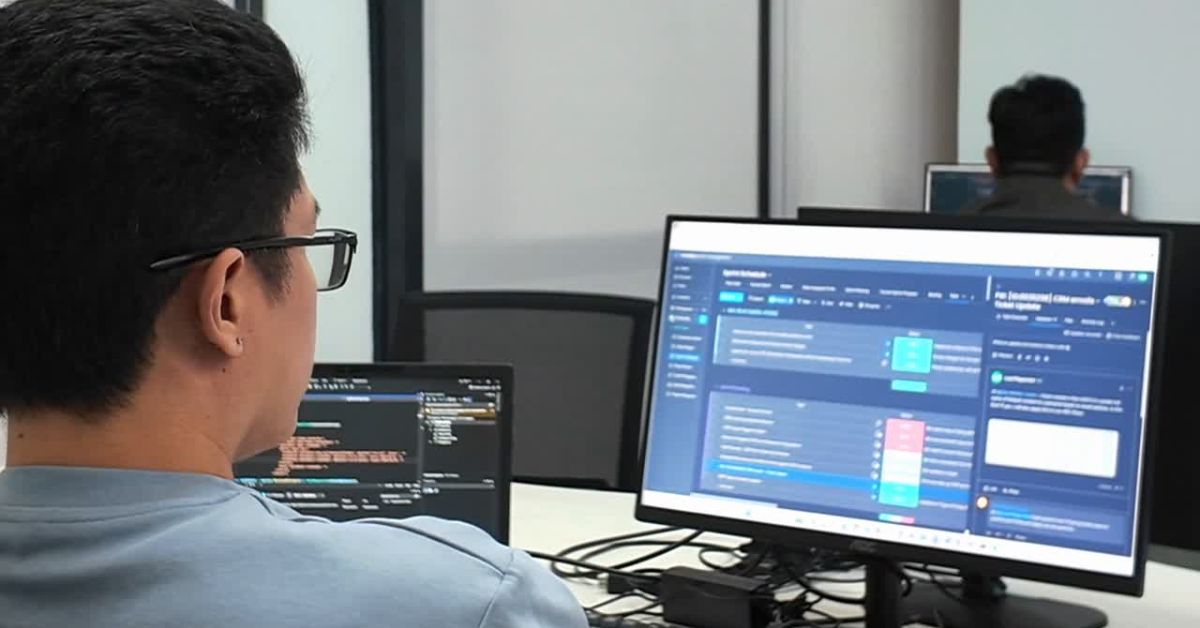Cloud Employee vs. In-House Hiring

📌 TL;DR
In-house hiring offers control but comes with rising costs, extended hiring cycles, and attrition risks. By contrast, Cloud Employee delivers vetted engineers in under three weeks, embedded into your team, with 97%+ retention beyond two years, at 50–75% lower costs than in-house employment. This review provides a deep analysis of in-house hiring models, their challenges, and Cloud Employee’s model.
Hiring In-House in Context
Hiring in-house remains the standard and most common approach for technology companies. Organisations employ staff (for the purposes of this article, developers) directly on long-term contracts, governed by employment law. These contracts guarantee benefits such as pensions, healthcare, paid leave, and structured career progression. In-house teams often form the backbone of core product development, governance, and IP protection, particularly in industries such as fintech, healthtech, travel, and SaaS where regulatory oversight and data security are paramount.
The financial reality, however, is stark. In 2025, CompTIA reports that the median tech salary in the US is USD 112,667 (CompTIA: State of the Tech Workforce 2025), with senior engineers commanding significantly more. In the UK, the median sits at £44,949, about 52% higher than the national average (CompTIA UK). For scale-ups competing against Big Tech and established corporates, this has created unsustainable competition for talent.
In-House Process and Pressure Points
Every CTO understands the mechanics. What matters now are the inefficiencies.
- Time-to-hire: SHRM’s benchmarks place the average at 44 days, with senior roles often stretching into 90–120 days (SHRM; Forbes). This delay is not just an HR statistic; it directly impacts roadmap velocity. Each month a senior developer role remains unfilled, opportunity cost accumulates; features slip, customer commitments stretch, and competitors capture market share.
- Candidate experience: Forbes notes interview loops are expanding, with multi-stage processes lasting 44+ days. Lengthy processes mean top candidates disengage or accept faster offers elsewhere. For companies in fast-moving sectors, this creates a talent bottleneck.
- Attrition exposure: CompTIA highlights 21% global attrition in IT roles. High turnover negates the supposed long-term stability of in-house models. The cost of backfilling (recruitment fees, manager time, lost productivity) can easily exceed 30% of annual salary per departure.
For candidates, in-house roles offer security and career development. Benefits packages, employer brand prestige, and defined career ladders continue to attract engineers. But market dynamics mean employers are increasingly competing on salary escalation rather than differentiated value, driving costs further upward.
Business Model of In-House Employment
The in-house model still dominates modern employment (consider it a more ‘traditional’ model): the majority of staff globally are employed as full-time staff under permanent contracts. This of course differs by region and industry. For employers, this model entails full financial accountability for wages, pensions, healthcare, payroll taxes, compliance, and infrastructure. Employees are bound by statutory rights and receive legally mandated protections.
The model ensures continuity, trust, and depth of expertise. But it is inflexible: scaling up requires months of hiring, while scaling down in downturns can trigger redundancy costs, legal disputes, and reputational risk. The entire employment risk sits within the business, magnifying exposure during volatile funding cycles or sudden market contractions.
Core Value Proposition of Hiring In-House
Hiring in-house delivers significant strategic advantages that should not be overlooked:
- Control and governance: In-house teams report directly into your leadership structure. This ensures alignment with internal priorities, tighter adherence to architectural standards, and full control of delivery schedules.
- Culture and cohesion: Employees become part of the company fabric, adopting its mission, vision, and values. For long-term innovation, having a workforce aligned to strategy is a genuine differentiator.
- Knowledge retention: In-house employees accumulate deep institutional knowledge. They understand legacy systems, product evolution, and cultural context, which can be challenging for external hires to replicate. This continuity reduces knowledge leakage and strengthens governance.
- Talent brand equity: Being an employer of record builds market credibility. Strong in-house teams reinforce a company’s reputation as a desirable place to work, which in turn attracts better candidates.
While powerful, these benefits now need to be weighed against the cost of employment, rising attrition, and the slow pace of scaling. The challenge for CTOs is to discern which roles genuinely require in-house employment and which can be augmented more effectively.
Evaluation: Strengths and Gaps
Strengths
- Deep domain expertise embedded within teams over years.
- Enhanced IP protection and governance capabilities.
- Strategic continuity, particularly in regulated sectors.
Gaps
- Speed: Senior hires often take 3–4 months to secure, slowing delivery momentum (LinkedIn Future of Recruiting 2025).
- Cost: Salaries in major markets have grown consistently faster than inflation. Median tech salaries remain at historic highs.
- Flexibility: Restructuring and downsizing incur significant legal and reputational costs, limiting organisational agility.
Cloud Employee in Strategic Context
For CTOs, the bottleneck is rarely knowing what talent they need, it’s the ability to access it fast, at the right cost, and without overloading HR or legal. In-house hiring gives deep cultural integration but comes with long lead times and high cost bases.
Cloud Employee offers a different model: staff augmentation at enterprise quality. Engineers are employed by Cloud Employee in LATAM, the Philippines, and European countries (like Croatia), but work as fully embedded members of your team (dedicated). You keep delivery ownership, while Cloud Employee takes responsibility for sourcing, HR, payroll, compliance, and retention. This removes structural hiring friction while maintaining control and technical standards.
Process and Delivery Model
Cloud Employee’s delivery model is designed to compress hiring timelines, reduce risk, and ensure sustained contribution:
- CTO-led vetting pipeline: Every candidate passes technical assessments, pair programming, and cultural fit checks before entering the pool. Only ~2–3% of applicants progress.
- Rapid selection and onboarding: We can hire & onboard within 2 weeks. We source & present 2 candidates to a client within 7 working days (from brief to shortlist of 2 fully vetted, best-fit candidates for any role. No bench. No delays (versus 44+ days for senior in-house hires).
- Embedded integration: Engineers join your workflows, ceremonies, and tools. Unlike contractors, they are not siloed, they operate as first-class members of your team.
- Retention framework: Cloud Employee manages benefits, training, career development, and performance support. This drives 97%+ retention beyond two years, protecting delivery continuity.
- Operational support: Compliance, payroll, L&D, and HR administration are handled entirely by Cloud Employee.
Strengths of the Cloud Employee Model
- Execution speed: Within 2 weeks from brief to onboarding.
- Cost efficiency: Engineers in LATAM/Philippines at 50–75% less than US/UK equivalents.
- Retention stability: 97%+ retention rate beyond two years.
- Risk transfer: CE handles payroll, compliance, and benefits.
- Scalability: Rolling contracts allow teams to flex without redundancy exposure.
Gaps to Acknowledge
- Geography and culture: Cross-border teams require structured integration practices.
- Management load: Your leaders retain day-to-day management; CE does not run delivery as a managed service.
How Cloud Employee Stacks Up Against In-House
Interpretation:
- Cloud Employee decisively outperforms in-house on time-to-hire, cost, retention, and risk management.
- In-house can retain advantages in long-term cultural cohesion if in-person contact is central to culture.
- For most scale-up and growth-stage contexts, Cloud Employee is the more efficient lever to expand delivery without locking into long recruitment cycles or inflated salary structures.
Pricing Review: In-House vs Cloud Employee*
USA Employment Costs
- Contingent contractor: ~$26,880/month (~$160/hr)
- Full-time W2 employee: ~$18,056/month fully loaded
UK Employment Costs
- Contractor: ~£14,700/month
- PAYE employee: ~£9,531/month fully loaded
Cloud Employee Costs
- LATAM engineers: ~$6,000/month all-inclusive
- Philippines engineers: ~$4,500/month all-inclusive
Annualised Example (Senior Engineer)
- US W2: ~$18,056 × 12 = $216,672/year
- CE LATAM: $6,000 × 12 = $72,000/year
- CE Philippines: $4,500 × 12 = $54,000/year
Takeaway: Equivalent engineering capacity at a fraction of the cost — with faster onboarding and higher retention.
Note*: These are average costs as a representation of rates from Cloud Employee’s on the ground knowledge, these vary based on seniority, skills, experience, location, and are open to change.
Bottom Line
In-house hiring remains essential for governance-heavy and IP-sensitive roles. But for scaling product teams under time and cost pressure, the in-house model is increasingly inefficient. Cloud Employee’s process of CTO-led vetting, rapid onboarding, embedded integration, and managed retention, gives CTOs a scalable, low-risk way to extend delivery capacity without compromising control.




.avif)

